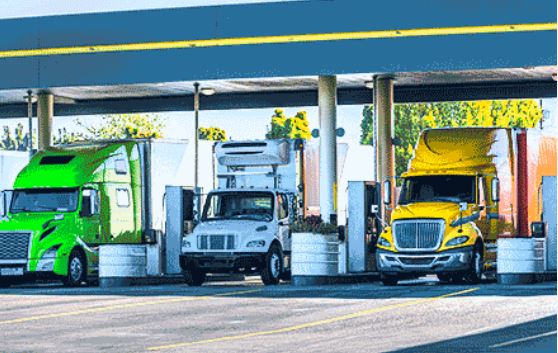
10 Ways Motor Carriers Can Increase Fuel Efficiency
As diesel prices continue to rise, motor carriers are seeking ways to reduce their fuel expenses.
In a 2021 survey by American Transportation Research Institute, truck drivers ranked fuel prices 3rd in their annual ranking of major concerns. Since the survey, fuel prices have continued to climb to around $5 per gallon, a price not seen since 2014.
According to ATRI, that per-gallon cost approached nearly 40 percent of a fleet’s marginal cost per mile in 2014, up from around 19 percent normally.
Recently, the North American Council for Freight Efficiency (NACFE) re-released a list of 10 actions truck drivers and motor carriers can take to increase their freight efficiency.
Currently, the national average fuel efficiency is 6.6 miles per gallon, according to the organization. NACFE suggests in its 2017 Run on Less study that these recommendations could help increase fuel efficiency to around 10 mpg.
“Fleets did things like add aerodynamic devices to their trucks and trailers, moved to low-rolling resistance tires and added tire pressure monitoring/inflation systems, focused on reducing idle time while keeping drivers comfortable,” said NACFE Executive Director Mike Roeth.
He also emphasized awareness among drivers. “They also recognized the importance of the driver in the fuel economy equation, and engaged drivers in helping the fleet become as efficient as possible.”
One of the key actions recommended in NACFE’s list was to build a culture of methodically choosing technologies.
“The best of the best fleets have a process in place that they follow rigorously when it comes to determining if a new technology makes sense in their operation, said NACFE’s Roeth. “Not all technologies are right for all fleets nor for every part of a fleet’s operation. Having a measured approach to evaluating efficiency enhancing technologies allows fleets to control those fuel expenses no matter the cost at the pump.”
Based on their research, here are the Top 10 actions NACFE recommendations to help increase fuel efficiency.
Use Downspeed Powertrains and AMTs
- It is important to use automated manual transmissions that enable other technologies such as downspeeding. The duty cycle is key to these choices and, in particular with downspeeding, buyers should only apply the most aggressive downspeeding only to tractors with high average speed (mph) where the amount of starts and stops are low.
Educate and Incent Conscientious Drivers
- The Run on Less study benefited by having the trucks operated by some of the most proficient drivers on the road. Hiring, educating, and incentivizing drivers for the best fuel efficiency possible is a critical part of a successful fuel management system.
Buy All Available Tractor Aerodynamics
- Fleets should start their specification process with all available sleeper tractor aerodynamics. NACFE has found that tractor aerodynamics have a very high ROI for line-haul applications and fleets should only remove items only if they suffer frequent damage in their specific operation.
Adopt Appropriate Trailer Aerodynamics
- Fleets should address trailer aerodynamics in relation to the side, rear, and front (the tractor-to-trailer gap) and adopt the most appropriate technologies depending on routes, drivers, maneuverability, etc.
Optimize Cruise Control and Vehicle Speed
- Fleets should maximize the parameter settings for cruise control to gain the most fuel savings. While a slower speed burns less fuel, there may be times when a faster speed can get a trucker more revenue. Thus the conditions dictate whether it make more sense economically to drive faster and burn more fuel
Keep Equipment Well Maintained
- The technologies employed on tractors and trailers work best when the trucks are well maintained. It is important to employ solid maintenance practices and utilize technology to help the equipment run as it is intended (e.g., automatic tire inflation on trailers, use of low-viscosity lubrication, alignment, replacing or cleaning all filters, etc.).
Implement the Right Axle Configuration
- Fleets should use the correct axle configuration for the job, depending on the payload, speed, maneuverability, fleet practices such as tire management, and even resale value if the asset will be sold before its useful life is exhausted.
Embrace Low Rolling Resistance Tires
- Low rolling resistance tires are critical for a fleet to get high mpg, but the most fuel-efficient tires are not right for every fleet, application, or region. A productive tire purchase and management process takes focus but will pay off.
Provide Tools to Reduce Idle Time
- Drivers should shut the truck off whenever and wherever possible and use technology and engine parameter settings to reduce idle time.
Build a Culture of Methodically Choosing Technologies
- Fleets should have a process to constantly monitor, adjust, and act upon new technology opportunities. Best practices include comprehensive understanding of the performance, either by testing or through industry involvement; robust payback or return on investment analyses; and supplier selection.
NACFE has completed Confidence Reports that provide unbiased views of more than 80 available technologies, including decision-making tools to help fleets and manufacturers in their efficiency efforts. Utilize their technology guide at nacfe.org to learn more about how to improve your operations and performance.
Note: These lists are not intended to be all-inclusive.
As always, you can count on the commercial truck insurance professionals at The Daniel & Henry Company to assist you through challenging claims and all of our insurance, risk management, and safety issues. Contact us today to discuss solutions for your transportation risk management program.

